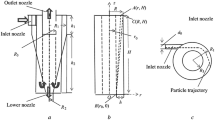Abstract
A procedure is developed for calculation of suspension-separation indicators of hydrocyclones using a regression model, which describes the suspension-separation process with a non-Newtonian dispersion medium in hydrocyclones, and is presented in the form of a relationship between the distribution of integral separation indicators over the height of the effective space and the determining similitude numbers and rheologic constants of the medium being separated. The influence exerted by the determining similitude numbers and rheologic constants of the medium being separated on the distribution of the degree of thickening of solid-phase particles over the height of the working space of the hydrocyclone is analyzed in conformity with the regression model obtained.
Similar content being viewed by others
References
M. G. Lagutkin and D. A. Baranov, “Calculation of indicators of suspension separation in a cylindrical direct-flow hydrocyclone,” Khim. Neft. Mashinostr., No. 3, 3–4 (1988).
M. G. Lagutkin, D. A. Baranov, and A. V. Markov, “Procedure for calculation of indicators of suspension separation in a cylindrical direct-flow hydrocyclone,” Khim. Neft. Mashinostr., No. 4, 2–21 (1991).
A. M. Kutepov, M. G. Lagutkin, and D. A. Baranov, “Method of calculating indicators of suspension separation in hydrocyclones,” Teor. Osn. Khim. Tekhnol., 28, No. 3, 207–211 (1994).
D. A. Baranov, A. M. Kutepov, and M. G. Lagutkin, “Analysis of separation processes in hydrocyclones,” Teor. Osn. Khim. Tekhnol, 30, No. 2, 117–122 (1996).
M. G. Lagutkin and D. A. Baranov, “Deterministic approach to analysis of the separating properties of a cylindrical-conical hydrocyclone,” Khim. Neft. Mashinostr., No. 5, 3–6 (2004).
E. A. Nepomnyashchii, A. M. Kutepov, V. V. Pavlovskii, and G. M. Konovalov, “Laws governing separation in a hydrocyclone,” Teor. Osn. Khim. Tekhnol., 13, No. 1, 86–90 (1979).
E. A. Nepomnyashchii and A. M. Kutepov, “Analysis of the carry-off of solid-phase particles from a conical hydrocyclone,” Teor. Osn. Khim. Tekhnol., 16, No. 1, 78–81 (1982).
A. M. Kutepov and I. G. Ternovskii, “Analysis of clarification indicators of diluted finely disperse suspensions by small-size hydrocyclones,” Khim. Neft. Mashinostr., No. 3, 20–23 (1972).
A. A. Kuznetsov, A. M. Kutepov, and I. G. Ternovskii, “Calculation of suspension-separation indicators in hydrocyclones,” Zh. Prikl. Khim., 55, No. 5, 1086–1090 (1982).
V. O. Yablonskii, “Analysis of the separation of suspensions with a non-Newtonian dispersion medium in a direct-flow hydrocyclone,” Khim. Prom., 82, No. 3, 40–48 (2005).
V. O. Yablonskii and G. V. Ryabchuk, “Modeling the deposition of solid-phase particles in a cylindrical-conical hydrocyclone during separation of suspensions with a non-Newtonian dispersion medium,” Teor. Osn. Khim. Tekhnol., 40, No. 4, 385–391 (2006).
V. O. Yablonskii, “Effect of structural parameters of a cylindrical-conical hydrocyclone on the separation indicators of suspensions with a non-Newtonian dispersion medium,” Khim. Neft. Mashinostr., No. 9, 3–7 (2005).
V. I. Sokolov, Centrifuging [in Russian], Khimiya, Moscow (1976).
S. L. Akhnazarova and V. V. Kafarov, Methods of Experiment Optimization in Chemical Engineering [in Russian], Vysshaya Shkola, Moscow (1985).
A. Byuyul and P. Tsefel, SPSS: Art of Information Processing. Analysis of Statistical Data and Revisiting of Hidden Mechanisms [in Russian], OOO DiaSoftYuP, Saint Petersburg.
V. O. Yablonskii and G. V. Ryabchuk, “Development of rotational film flow of a non-Newtonian liquid in a cylindrical pipe of finite length,” Teor. Osn. Khim. Tekhnol., 35, No. 5, 479–484 (2001).
Author information
Authors and Affiliations
Additional information
__________
Translated from Khimicheskoe i Neftegazovoe Mashinostroenie, No. 8, pp. 3–7, August, 2008.
Rights and permissions
About this article
Cite this article
Yablonskii, V.O. Use of regression equations to calculate suspension-separation indicators in hydrocyclones. Chem Petrol Eng 44, 417–424 (2008). https://doi.org/10.1007/s10556-008-9080-0
Published:
Issue Date:
DOI: https://doi.org/10.1007/s10556-008-9080-0



